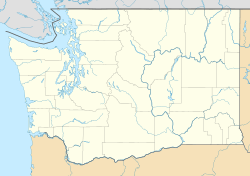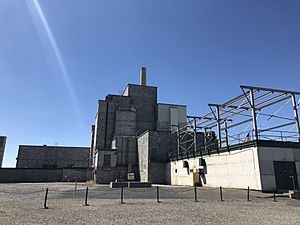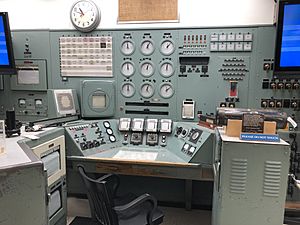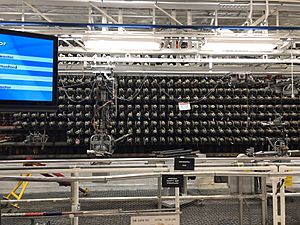B Reactor facts for kids
|
B Reactor
|
|

The face of B Reactor during construction.
|
|
| Location | About 5.3 mi (8.5 km) northeast of junction of State Route 24 and State Route 240 on the Hanford Site |
|---|---|
| Nearest city | Richland, Washington |
| Area | 9.5 acres (3.8 ha) |
| Built | 7 June 1943 to September 1944 |
| Architect | E.I. DuPont de Nemours & Company |
| NRHP reference No. | 92000245 |
Quick facts for kids Significant dates |
|
| Added to NRHP | 3 April 1992 |
| Designated NHL | 19 August 2008 |
The B Reactor at the Hanford Site in Richland, Washington, was the first large-scale nuclear reactor ever built. It started working on September 26, 1944. This reactor was a very important part of the Manhattan Project. The Manhattan Project was a secret United States program during World War II to develop nuclear weapons.
The B Reactor's main job was to change a type of natural uranium into plutonium-239. This plutonium was then used to make nuclear weapons. Scientists could easily separate the pure plutonium using chemicals. The reactor used graphite to control the nuclear reaction and water from the Columbia River to keep it from getting too hot.
Before the B Reactor, there was a smaller test reactor called the X-10 Graphite Reactor. The B Reactor was a huge step forward in reactor design. Companies like DuPont built it, and famous scientists like Enrico Fermi and Chien-Shiung Wu helped with its operation. Two other similar reactors, the D and F Reactors, started soon after. The plutonium made at Hanford was used in the first nuclear test, called the Trinity test. It was also used in the "Fat Man" bomb dropped on Nagasaki, Japan. This plutonium was also used in thousands of US weapons during the Cold War.
The B Reactor is historically important for many reasons. It was the world's first large-scale reactor. It was also the first to use water for cooling. It was the first to experience a problem called "xenon poisoning." It was also the first to make tritium for hydrogen bombs.
The reactor stopped working permanently in February 1968. Today, it is a U.S. National Historic Landmark. It is also part of the Manhattan Project National Historical Park. Visitors can take tours to see the reactor.
Contents
Building the B Reactor
The company E. I. du Pont de Nemours and Company designed and built the B Reactor. They used ideas from experiments done by Enrico Fermi at the University of Chicago. They also used information from the X-10 Graphite Reactor in Oak Ridge National Laboratory. The B Reactor was designed to produce 250 megawatts of heat.
The reactor's main goal was to create plutonium from natural uranium metal. Getting a special type of uranium, called 235U, was very hard. But plutonium could be separated much more easily. For example, a plant in Tennessee that enriched uranium needed a lot of silver and many workers. The B Reactor, however, needed fewer workers and special materials. The most important material was 1,200 tons of very clean graphite. This graphite helped control the nuclear reaction. The reactor also needed electricity to run its cooling pumps.
The B Reactor building is about 46 feet by 38 feet and 41 feet tall. Inside, the reactor core is a large graphite box. This box is 36 feet tall and weighs 1,200 tons. It has 2,004 aluminum tubes running through it horizontally. These tubes hold the fuel. There are also vertical channels for control rods.
A thick shield of cast iron surrounds the core. This shield is 8 to 10 inches thick and weighs 1,000 tons. Other plates of material cover the shield. These layers protect people from radiation. The bottom of the shield rests on a 23-foot-thick concrete base. Graphite was chosen to help control the nuclear reaction. The reactor was fueled by 200 tons of metallic uranium slugs. These slugs were about the size of a roll of quarters. They were sealed in aluminum cans and loaded into the aluminum tubes.
The reactor used water from the Hanford Reach of the Columbia River for cooling. Water was pumped through the aluminum tubes and around the uranium slugs. It flowed at a rate of 75,000 gallons per minute. After cooling the reactor, the water went into special settling basins. There, short-lived radioactive waste decayed. Any particles settled out, and the water cooled down. Then, it was released back into the Columbia River.
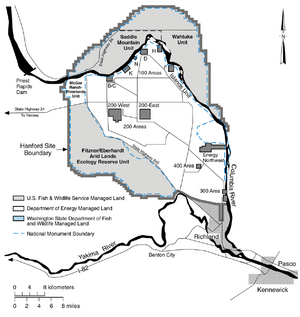
How the Reactor Worked
The B Reactor started its first nuclear chain reaction in September 1944. The D Reactor followed in December 1944, and the F Reactor in February 1945. At first, there was a problem. A substance called Xe-135 absorbed too many neutrons. Scientist Chien-Shiung Wu helped figure this out. The problem was solved by adding more uranium fuel. The reactor made plutonium-239 by exposing uranium-238 to neutrons from the nuclear reaction.
The B, D, and F reactors were built about six miles apart along the Columbia River. Each reactor had its own buildings. These included a pump house for river water, large storage basins, a water filter, and pumps to deliver water to the reactor. They also had systems for emergency cooling.
To quickly shut down the reactor, called a SCRAM, workers would rapidly insert vertical safety rods. As a backup, they could inject water containing borate into the reactor. Later, in 1952, a new system was added. It injected special steel balls containing boron into the safety rod channels.
The plutonium used in the Trinity test in New Mexico came from the B Reactor. This was the world's first nuclear explosion. Plutonium from the B Reactor was also used in the "Fat Man" bomb. This bomb was dropped on Nagasaki, Japan. The B Reactor operated for two decades. It was finally shut down permanently in February 1968.
The B Reactor Today
The United States Department of Energy has managed the B Reactor site since 1977. They offer public tours on certain dates in the spring, summer, and fall.
As of 2014, most of the other production reactors at Hanford were in "interim safe storage." This means they were being prepared for long-term storage. But the B Reactor was given special status because of its historical importance.
Many reactor buildings have been "cocooned" or "entombed." This means the buildings are taken down to the thick concrete shield around the reactor core. Any openings are sealed, and a new roof is built. This helps keep the area safe. The C reactor was cocooned in 1998. The D reactor was cocooned in 2004. The F reactor was cocooned in 2003. The H reactor was cocooned in 2005. The N-Reactor was cocooned in 2012. The Department of Energy inspects these decommissioned reactors every five years.
The K East and K West reactors were built in the 1950s. They were shut down in the early 1970s. Plans for stabilizing these reactors were underway as of 2018.
The B Reactor was added to the National Register of Historic Places in 1992. It was named a National Historic Landmark in 2008. In 2014, a law made the B Reactor part of the Manhattan Project National Historical Park. This park also includes historic sites in Oak Ridge, Tennessee and Los Alamos, New Mexico. The park was officially created in November 2015.
Important Dates for the B Reactor
| Year | Date | Event |
|---|---|---|
| 1943 | October | The U.S. Army Corps of Engineers starts building the B Reactor. |
| 1944 | 13 September | The first uranium fuel is loaded into the B Reactor. |
| 1944 | 26 September | The reactor starts its first nuclear chain reaction. |
| 1945 | 3 February | Plutonium from the B Reactor is sent to Los Alamos. |
| 1945 | 16 July | B Reactor plutonium is used in the world's first nuclear explosion in New Mexico. |
| 1945 | 9 August | B Reactor plutonium is used in the Fat Man bomb dropped on Nagasaki, Japan. |
| 1946 | March | B Reactor operations are paused. |
| 1948 | June | B Reactor operations start again. |
| 1949 | March | B Reactor begins making tritium for hydrogen bombs. |
| 1954 | 1 March | B Reactor tritium is first used in a test of a hydrogen bomb at Bikini Atoll. |
| 1968 | January 29 | The Atomic Energy Commission orders the B Reactor to shut down. |
| 1976 | The B Reactor is named a National Historic Mechanical Engineering Landmark. | |
| 1994 | The B Reactor is named a National Historic Civil Engineering Landmark. | |
| 2008 | The B Reactor is named a National Historic Landmark. | |
| 2009 | The U.S. Department of Energy announces public tours. | |
| 2011 | July | The National Park Service suggests the B Reactor be part of a national park for the Manhattan Project. |
| 2014 | December | A law includes the B Reactor in the Manhattan Project National Historical Park. |
| 2015 | 10 November | The Manhattan Project National Historical Park is officially created. |
See also
 In Spanish: Reactor B para niños
In Spanish: Reactor B para niños


